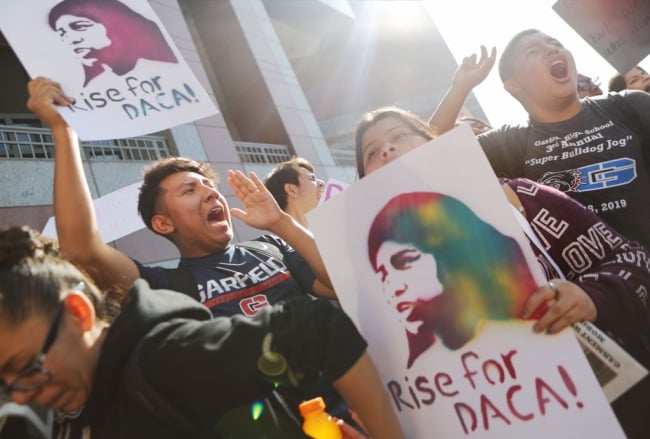You have /5 articles left.
Sign up for a free account or log in.

Low-income, undocumented student enrollment has fallen at UC and CSU campuses as DACA eligibility dries up, a new study says.
Mario Tama/Getty Images North America
The number of undocumented, low-income students newly enrolling at University of California and California State University campuses has fallen by half since the 2016–17 academic year, according to a new study from the University of California Civil Rights Project at UCLA and the UC Davis School of Law.
The study’s authors connect this downward trend to a national issue—what they call the “slow strangulation” of the Deferred Action for Childhood Arrivals (DACA) program, which protects people from deportation and authorizes them to work in the country legally if they were brought to the U.S. as children without authorization. But due to legal setbacks, political challenges and the requirement that recipients of the Obama-era program must have arrived in the U.S. before 2007, it’s inaccessible to most high school students today.
Kevin R. Johnson, co-author of the report and a professor and former dean of the UC Davis School of Law, said that because undocumented people of a traditional college age increasingly lack DACA status, it’s harder for them to get well-paying jobs, since they can’t work legally and can’t take jobs on campus. That can make college feel impossible to afford.
“It’s hard enough for students who are citizens to fund their education through loans, work and otherwise,” he said. “Many of us have memories of working long hours as students to fund our education, but if you can’t work lawfully, it’s very difficult to proceed.”
The study draws on data from the California Student Aid Commission, which administers state aid to low-income and undocumented students. The study found that enrollment of undocumented students who received aid on UC campuses dropped 51 percent, from 1,181 students in the 2016–17 academic year to only 579 in 2022–23. CSU campuses had a similarly alarming loss, a decline of 48 percent, from 2,219 undocumented students who received aid in 2016–17 to 1,148 in 2022–23. The study compares low-income, undocumented students’ enrollment numbers to those of other student groups—and finds similar declines didn’t occur among other low-income and lower-middle-income students with similar high school grades.
Co-author William C. Kidder, research associate at the UCLA Civil Rights Project, noted in a press release how consistent the results were across the two university systems. “I believe that underscores how common it is for young Gen Z undocumented college students to struggle when DACA is beyond reach and when they are excluded from campus jobs and surrounding labor markets,” Kidder said.
That’s in spite of the fact that California offers more support to undocumented students than many other states, as Miriam Feldblum, executive director of the Presidents’ Alliance on Higher Education and Immigration, pointed out. While they can’t work legally, those students are eligible for in-state tuition and can receive state aid. (Currently, 25 states and Washington, D.C., allow in-state tuition for undocumented students, and of those states, 19 also offer state financial aid, according to the Higher Ed Immigration Portal.)
The California Student Aid Commission has also undertaken significant work to try to ensure more undocumented students take advantage of aid dollars. Some changes were made to the application for state aid for undocumented students this year to make it easier to apply, based on a work group convened to improve it.
California is at least a “proactive place,” Feldblum said. “They’re kind of leaders at looking at their own implementation and realizing what they need to do to improve.” So she agrees the decline must stem from broader forces and factors beyond the state. Her own organization has documented a national decline in the undocumented college student population in recent years.
She stressed that, even with DACA hampered and less accessible, there are ways for universities to stem declines, including partnering with K-12 schools to reach undocumented students earlier and collecting higher-quality data on their enrollment, persistence and graduation rates to better understand how to support them.
“If we’re going to ensure, enable, encourage immigrant students, including undocumented students, to access higher education, we have to understand what supports they need in high school,” she said.
California lawmakers responded to the problem by passing a law that could address one source of the enrollment decline—although it was vetoed on Sunday by Governor Gavin Newsom. The bill, which would allow undocumented students to work on-campus jobs in the state’s public higher ed systems, followed a hunger strike by undocumented students and their advocates, who unsuccessfully pushed to get the UC Board of Regents to adopt the policy earlier this year. If Newsom hadn't vetoed the bill, leaders of the systems worried it might not hold up in court, putting their federal funding at risk. (Note: This paragraph has been updated to reflect Newsom's veto on Sunday.)
The legislation was based on an untested legal theory by the Center for Immigration Law and Policy at UCLA, which suggests that the law barring employers from hiring undocumented immigrants doesn’t apply to states or state entities such as public universities. A 2022 memo detailing the theory was signed by 29 constitutional and immigration law scholars, including Erwin Chemerinsky, dean of the UC Berkeley School of Law.
The report’s authors argue the bill could have been a promising way to address undocumented students’ lack of access to steady employment. The report describes California as “an upper-bound test case with the strongest, longest and arguably most robust set of state laws and university-level aid policies” to support undocumented students. And yet, even in California, those supports haven’t staved off the ripple effects of the “gradual demise” of DACA, forcing the state to entertain a more innovative possible solution. If DACA goes before the Supreme Court a second time and is struck down, these kinds of state-level experiments will be all the more important, the report argues.
Johnson said that California’s public universities can’t ignore the problem that led to its passage—the fact that undocumented students need steadier access to income streams.
“One of the things that the public universities are good at doing is ensuring access to all people who are qualified to attend our wonderful universities,” he said. “We’re currently in a situation where highly qualified students who live here and have lived here for a long time, many of them aren’t having the ability to attend our universities. And it has all kinds of consequences on their lives and also on the diversity of our campuses.”









![First text message: "Yes?" Second message: "This is embarrassing to say, but law school isn't fair for us men, the women are always outperforming us at [sic]. It's obvious women are taking over the legal profession nowadays." Third text: "Who is this?"](/sites/default/files/styles/image_192_x_128/public/2024-09/Text_messages_law_2.jpg?itok=0QWP419B)